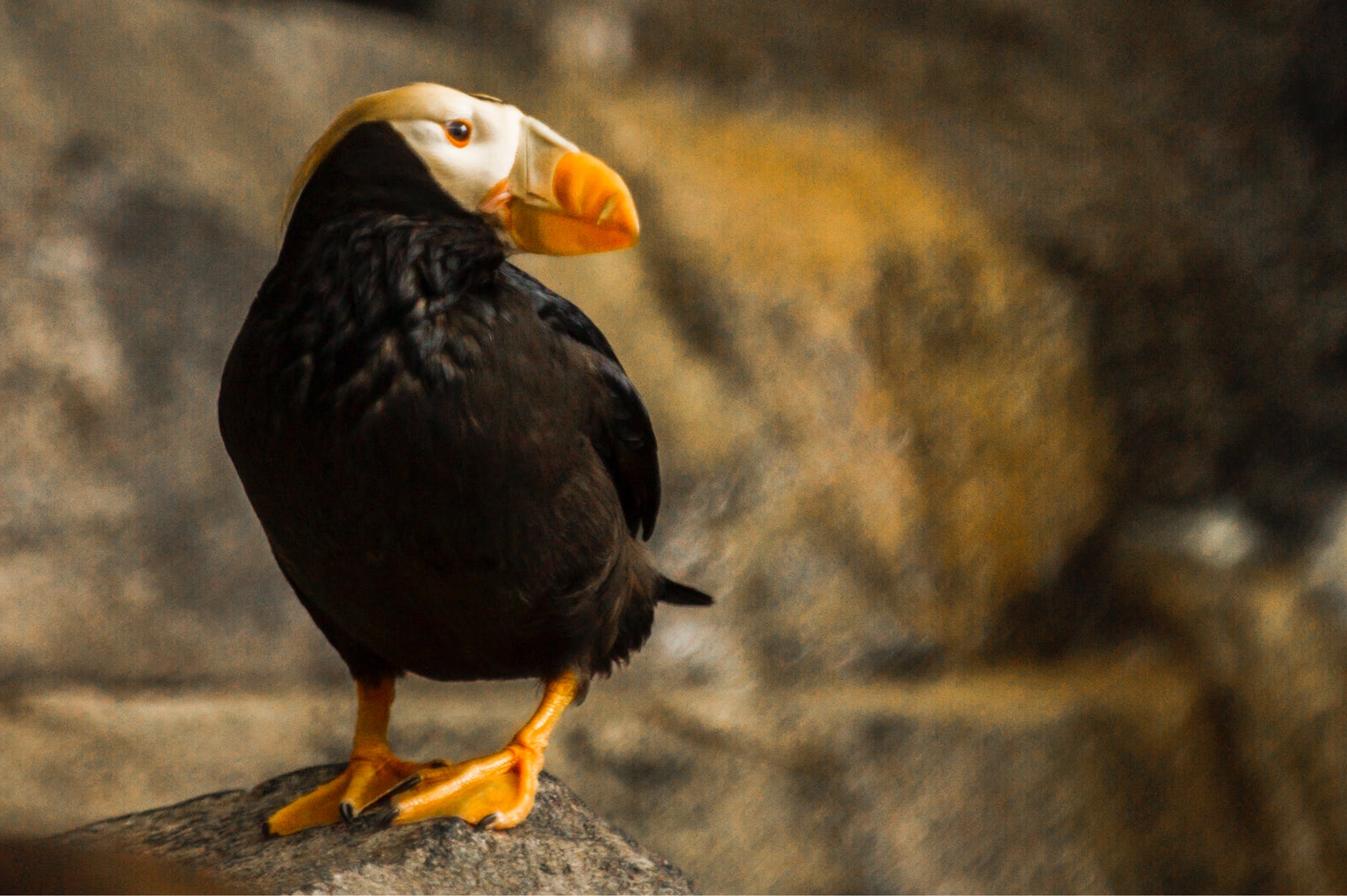
Everything You Ever Wanted to Know About Tufted Puffins
Solid black seabirds with orange feet, tufted puffins are fairly stocky and have rounded heads. They are distinctive because of their facial coloring and plumage. With an orange bill and a white face, they are adorned by wisps of blonde feathers that sweep backwards from the ears. In size, they are similar to pigeons.
The tufted puffin, though, is the largest puffin and can live 20 years or longer.
Behavior
Unlike other birds, they need a running start to take to the air. They can dive and even swim underwater at great depths up to 200 feet while staying underwater for a minute or more. They use their wings and feet to steer underwater to feed on small fish, which they catch in their bills. Tufted puffins have denticles on the top of their mouth and a locking tongue that allows them to grab and hold on to large numbers of birds crosswise.
During the breeding season, they catch and carry a large number of fish – often exceeding 12 at a time – which they bring back to the nest. In Maine, one documented event details a tufted puffin with 62 fish in its mouth.
Diet
In addition to small fish, they also feast on mollusks, cephalopods, and crustaceans, including squids, octopus, crabs, and jellyfish. They also hunt capelin, sand eels, herring, and hake.
Colonies & Nesting
The number of tufted puffin colonies vary in size each year, depending on local food supplies and climate events like El Nino. They are migratory, spending the winter breeding season off shore as far as 120 miles away.
They breed in colonies, most typically on islands with steep slopes or on cliff tops. During the day, they are active in the colonies. You might see them most often sitting upright on rocks.
Tufted puffins form attachments and pair long-term with partners for breeding. The duo spends a significant amount of time preparing nesting sites, using their feet and bills to dig. Burrows can be as long as 7 feet with a end chamber, which they fill with grass, seaweed, or feathers. Often, they will build the nest site in one year, but wait until the following breeding season to occupy.
The female lays a single egg during breeding season. Both parents will tend to it during the 6-7 week incubation period, and also care for the young for another 6-7 weeks. After that period, the young tufted puffins leave the nest and head to sea. If they aren’t ready to fly, you may see them walking towards water.
Endangered Status
The tufted puffin was one of the most common seabirds in the Northwest, but the numbers have diminished greatly in recent years. The Audubon Society estimated there are less than 3,000 left in Washington State and less than half of the normal breeding grounds are occupied. The state listed it as an engendered species in 2015. Breeding colonies are protected in the state, but an increase in gull populations have also taken its toll. They prey on the tufted puffin young.
Populations in California have shrunk dramatically and disappeared completely in some areas. There have also been significant population declines in Oregon and Japan. Still, estimates place the tufted puffin population worldwide at approximately 6 million.
Tufted Puffin Fun Facts:
- Nickname: Sea Parrot, Clown of the Sea
- Speed: Can reach speeds of 55 mph
- Diving Range: Can dive up to 200 feet below surface
- Catch & Carry: Can grab and carry more than 20 fish at once
- Pairing: Pairs of tufted puffins will sometimes rub their beaks together. This “billing” draws a crowd of onlooker puffins.
- Life span: 20 years
- Predators: Gulls, Rats, Foxes
The National Marine Sanctuary System
Spanning more than 620,000 square miles, from Michigan to Florida and Cape Cod to American Samoa, the National Marine Sanctuary System includes 13 national marine and Great Lakes sanctuaries and two marine national monuments. These unique waters sustain critical, breathtaking marine habitats that provide homes to endangered and threatened species. They preserve America’s rich maritime heritage. They are literal living laboratories for science, research, education, and conservation. Sanctuaries also offer world-class outdoor recreation experiences for all ages and support local communities by bringing billions of dollars to their economies.
The National Marine Sanctuary Foundation
The National Marine Sanctuary Foundation is the national non-profit partner for the National Marine Sanctuary System. Founded in 2000 by America’s most influential ocean conservation leaders, the Foundation raises awareness of and support for national marine and Great Lakes sanctuaries and their vital role to ensure a healthy ocean.
The Foundation promotes citizen science, research, conservation, education and community engagement to protect coral reefs and marine habitats, preserve places of cultural significance, and conserve our maritime history and heritage.
Whether it’s saving whales, cleaning up marine debris, or inspiring the next generation of ocean stewards, our work starts with great ideas and affects change.
